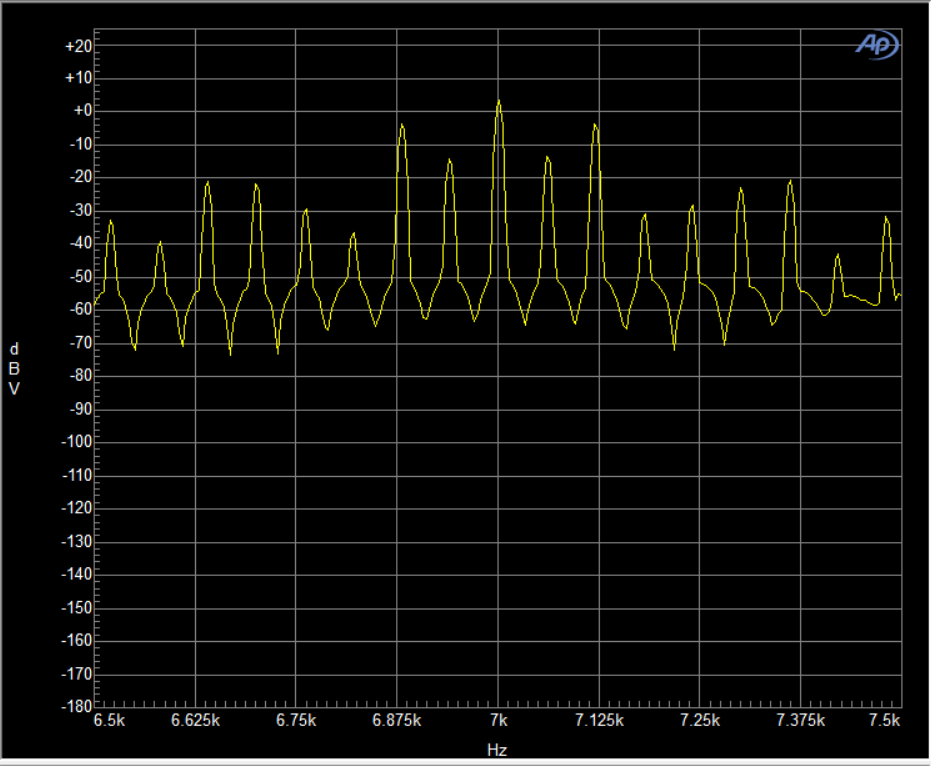The first time someone paid me to run sound for them, I was sitting by the side of the stage twiddling the knobs of a Shure Vocal Master – or Muddle Master as my friend Steve Johnson would say! Johnny Saturn and the Electrics, a 50’s band that really just wanted someone to turn the reverb on and off.
So I figured as I jump back into the world of audio it might be fun to do a side by side of a beginner’s sound system in 1975 and around 2022. Now that I think about it, the first audio device I fixed for $$ was a Vocal Master – different band though. I didn’t blow Johnny’s Vocal Master.
For our “Now” PA I’ve selected a Mackie 1604 VLZ connected to one channel of a Crown D150 Series 2. While each of these is not exactly current, they are readily available on the market and a starting band might buy them. I ran each of these systems through a series of tests with the Audio Precision, and here are the results.
Frequency Response & THD+N
It’s incredibly easy to measure frequency response and THD+N and seeing them together is sometimes informative. I tested each system at 1 watt of output and again at or near 75 watts. The Vocal Master struggled a bit at 75 watts, so some measurements were made closer to 65 watts.
First, the Muddle Master, er Vocal Master at 1 watt output. The red line is THD+N and the green line is frequency response.
Note the bright red arrows pointing to the THD+N scale of 5.5% and 4% THD+N peaks at about 5.5%, and never gets below 4%. That’s a lotta distortion! You may have also noted the green line is a little less than ideal, down 8.5dB at 20Hz, up a tad at 200-500, 0dB reference at 1k and then down 4.5dB at 20kHz. Mr. Johnson was correct!

OK, let’s check our more modern friend. Note the red arrow is pointing at .05% rather than 5% THD+N, a significant improvement. Also, frequency response is well within 1dB from 20-20kHz.

Louder’s better, so let’s try again at power and see if we make the Vocal Master any better. Distortion is better, it gets way down to 1% in the mid-range but gets pretty close to 5% at 20Hz. At 1 watt, noise is certainly contributing N to the THD+N, but there is visible distortion even at 1 watt. Frequency response is plotted in watts this time, but you get the picture.

Back to our present-day system, we’re not only louder (and flatter), THD+N is even lower, almost .005% in the midrange.

Now let’s look at a different kind of distortion; intermodulation distortion, or IMD. This is what happens when more than one tone is feeding through the system. Obviously, we care about complex signals, because, very few people play pure sine waves.
First up is the US version of IMD testing where a 7,000 signal is mixed with a 60Hz signal and the 7kHz signal is 4 times louder than the 60Hz. I ran this a few times and kept lowering the volume. It was well below full volume and the results were pretty abysmal.
It’s worth looking ahead to the Mackie/Crown version of this test to see what it is supposed to look like. Just know that this is not a good result.

This is much better. You can see some minor artifacts above and below the tall spike at 7kHz, but they are 85dB or so down, not 5dB like the Vocal Master.

And finally, the European method of testing IMD is to use a 13kHz and 14kHz tone, at equal volumes and see what is produced. This should give 2 spikes and some low-level artifacts above and below at 1kHz intervals.
The Vocal Master is slightly better in this measurement, but do compare to the Mackie/Crown combo.

And now the Mackie/Crown. You cannot distinguish any artifacts from the noise, which is good! The noise is a bit high, peaking at -80dB or so, but there are no distortion components.

Conclusion
So there you have it. It isn’t just computers that have gotten smaller and faster since 1975, audio electronics have progressed as well. And we won’t even start on the speakers!
I cannot recall the princely sum a Vocal Master sold for back in the day, but I have to guess the current system proposed would be in the same general price range in today’s dollars.
One thing is for certain, or should I say for Shure, while Vocal Masters are “vintage” I wouldn’t want to use one on anything today.